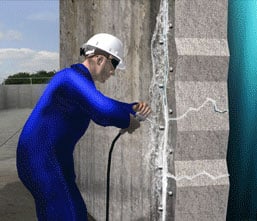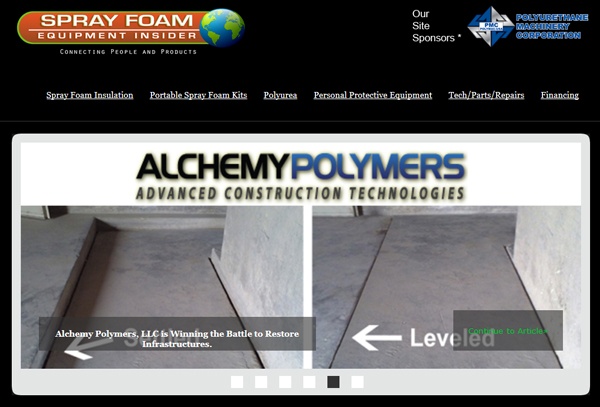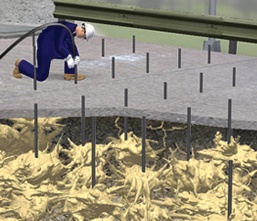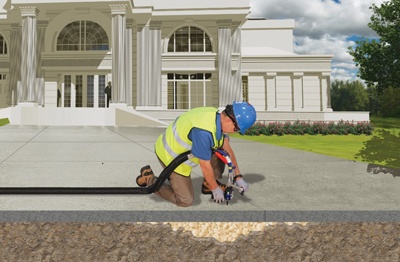 In this article, I'll highlight a few of our most informative blog posts on the subject of polyurethane leak seal.
In this article, I'll highlight a few of our most informative blog posts on the subject of polyurethane leak seal.
Alchemy Polymers founder Stephen Barton wrote an extremely educational multi-part series on concrete crack injection. These articles provide detailed instruction on sealing leaks with polyurethane grout. We'll start with an excerpt from the first post in that series. This is a great subject to explore if you're new to polyurethane leak seal or want a thorough refresher course.
Next, we'll take a look at an excerpt from a 3 part series I wrote about sealing leaks on remote job sites. Not every job is set in an ideal, easy to access setting. Look into this subject if you want to prepare yourself for the inevitable, out of the way, difficult leak seal job.
Lastly I'm including an excerpt from a dramatic case study, written by Stephen Barton, in which Orange County, FL municipal workers tried AP Fill 700 for the first time. Much to their surprise, they quickly stopped a gushing leak in record time - saving 90% of their usual material usage in the process! Read this article for a true story about our powerful polymers, being applied with painless procedures, to achieve the rapid results most contractors, property owners and engineers want from a polyurethane leak seal product.
5 Steps of Concrete Crack Injection - Overview
There are five basic steps to be done when injecting a crack in concrete that is leaking water. This is crack injection 101. Learn these steps and you will be well on your way to understanding what it takes to seal a water leak in concrete. In the rest of this series, we will explore every one of these steps in more detail and address the multitude of options (such as port selection, hole spacing, depth, what to do when you hit rebar, etc.) But for right now, we are going to discuss the most basic steps.
Step 1: Drill holes. Use a hammer drill to drill holes in the concrete that intersect the crack. These holes are usually drilled at a 45 degree angle to intersect the crack halfway through the structure so that the resin is forced towards the front and back of the crack.
Step 2: Flush the holes. When you drill, you create concrete dust. If you don’t flush this dust out of the holes, it will be forced into the crack during injection and may clog the crack preventing resin from getting where it needs to go. Put a flexible hose all the way to the back of the hole so that water flushes the dust from the back of the hole to the surface of the concrete. Flush until clean water is flowing.
Step 3: Install your injection port. The port is what seals the hole and gives the injection pump a direct connection to the crack.
Read about steps 4 and 5 in the post 5 Steps of Concrete Crack Injection - Overview.
Sealing Leaks on Remote Job Sites
Hopefully these tips on overcoming obstacles on remote job sites will be of assistance on your next out of the way project. Last summer I had the opportunity to repair pipe penetrations of aerial manholes along a drainage basin in SW Atlanta. Aerial manholes are typically found in low spots next to creeks and rivers. They are usually connected by steel or ductile iron sewer pipes that are above ground and thus, so are the penetrations.
The conditions of the job site were unique as there was no access to the individual manholes except by foot. This particular project covered a winding 1-1/2 miles through ravines and involved several crossings of the stream. The goal was to seal the 18” and 22” pipe penetrations that were leaking raw sewage down the faces of the manholes located along the creek. In this report I will let you know how we got started in preparation for the unique set of challenges this project presented.
Read more in the post Sealing Leaks on Remote Job Sites – Part 1.
AP Fill 700 Saves Orange County 90%
We were asked to do a demonstration for the Utilities division of Orange County, FL (which includes Orlando). They have a crew that does infiltration grouting among other things.
We were supposed to demonstrate our product on a fairly slow leak in a manhole. Not by design, but this was the leak they were scheduled to fix in the time frame we had scheduled the demo. Originally, they asked me to bring 5 pails of AP Fill 700. I also brought both our slow and our fast catalyst.
When I showed up in the morning, they told me they found a different leak which was a gusher. They asked if I had about 10 pails. I told them I only brought five. They said “we’ll try your stuff first, then finish up the leak with the current product we are using.”
We showed up to the jobsite and Tom, who has been doing leak seal for many years, said basically the same thing. “That’s all you brought?” Tom was quite a skeptic - at first.
Read more in the post AP Fill 700 Saves Orange County 90%.
Want more in-depth info on polyurethane leak seal?









 In this post, I'd like to highlight a couple of our earlier articles on seawall repair.
In this post, I'd like to highlight a couple of our earlier articles on seawall repair.
 In this post we'll take a look at a couple of important, early articles we posted on soil stabilization.
In this post we'll take a look at a couple of important, early articles we posted on soil stabilization.
 In this article, I'll highlight a few of our most informative blog posts on the subject of polyurethane leak seal.
In this article, I'll highlight a few of our most informative blog posts on the subject of polyurethane leak seal.  Over the past few years, we've published quite a few blog posts on the subject of slab lifting. In this post, I'm going to highlight a few of our earlier articles covering some of the most common questions people tend to ask on the subject. Contractors who are considering getting into the business often wonder about the strength of polyurethane foam, where to look for lifting jobs, and how to estimate the amount of material they may need for a particular job. Fortunately, we have thorough blog posts on each of those subjects.
Over the past few years, we've published quite a few blog posts on the subject of slab lifting. In this post, I'm going to highlight a few of our earlier articles covering some of the most common questions people tend to ask on the subject. Contractors who are considering getting into the business often wonder about the strength of polyurethane foam, where to look for lifting jobs, and how to estimate the amount of material they may need for a particular job. Fortunately, we have thorough blog posts on each of those subjects. 